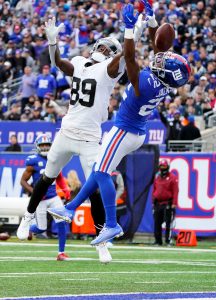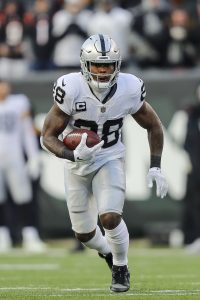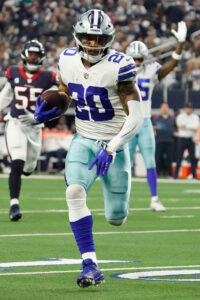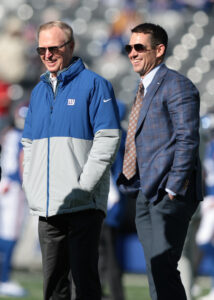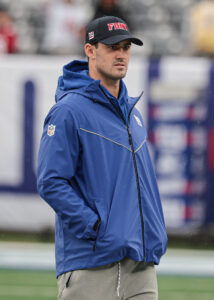A valuable tool for teams to keep top free agents off the market, the franchise tag has been in existence since 1993. This week brought the opening of the 2024 tag window. Clubs have until 3pm CT on March 5 to apply tags. As the Giants’ situation showed last year, most of the tag-related business comes near the close of this window. Teams will continue to work toward re-signing their respective tag candidates, thus preventing a lofty franchise tender from hitting their cap sheet.
The legal tampering period opens March 11, with the new league year (and official free agency) starting March 13. Once a player is tagged, he has until July 15 to sign an extension with his respective team. Absent an extension agreement by that date, the player must play the 2023 season on the tag (or go the Le’Veon Bell/Dan Williams/Sean Gilbert route, passing on guaranteed money and skipping the season).
High-profile free agents remain weeks away from hitting the market. As PFR’s tag recipients list shows, a handful of players are prevented from taking their services to free agency each year. This year looks to present a few more tag candidates compared to 2023. With a handful of teams determining if they will need to use the tag to prevent a free agency path, here are the players who figure to be tagged or at least generate conversations about being franchised ahead of the March 5 deadline:
Locks
Josh Allen, OLB (Jaguars)
Tag cost: $24MM
GM Trent Baalke did not leave much suspense when he addressed Allen’s future last month. The veteran exec said the 2019 first-round pick will be a Jaguar in 2024, indicating the team would use its franchise tag if necessary. The Jaguars do have Calvin Ridley as a free agent, but the team would owe the Falcons a 2024 second-round pick if it extended the wide receiver’s contract before the start of the league year. The second pick sent to Atlanta will only be a third-rounder if Jacksonville lets Ridley hit free agency. It makes more sense for Jacksonville to circle back to Ridley after allowing him to test the market. An Allen tag effectively ensures that will happen.
 Timing his sack breakthrough well, Allen registered a Jags-record 17.5 during his contract year. The five-year Jaguar has combined for 55 QB hits over the past two seasons and ranks top 10 in pressures over the past three. The tag regularly keeps top edge rushers from hitting free agency, and the 26-year-old pass rusher — while obviously wanting to be paid what he’s worth — expressed a desire to stay in Jacksonville long term.
Timing his sack breakthrough well, Allen registered a Jags-record 17.5 during his contract year. The five-year Jaguar has combined for 55 QB hits over the past two seasons and ranks top 10 in pressures over the past three. The tag regularly keeps top edge rushers from hitting free agency, and the 26-year-old pass rusher — while obviously wanting to be paid what he’s worth — expressed a desire to stay in Jacksonville long term.
The Jags have regularly unholstered their tag during the 2020s, cuffing Yannick Ngakoue in 2020 and then keeping Cam Robinson off the 2021 and ’22 markets. The team kept Evan Engram out of free agency last year. Robinson signed an extension in 2022, and the Jags re-upped Engram last July. The Ngakoue situation could be notable, as the edge rusher became disgruntled with the Jags and was eventually traded to the Vikings that summer. No signs of that level of trouble are brewing with Allen yet.
Jaylon Johnson, CB (Bears)
Tag cost: $19.8MM
Johnson is likely to become the first franchise-tagged cornerback since the Rams kept Trumaine Johnson off the 2017 market. The Bears are the most recent team to tag a corner, using the transition tag to cuff Kyle Fuller in 2018. They will almost definitely follow suit with Johnson, who has been rumored to be tagged for several weeks. A Ryan Pace-era draftee, Johnson expressed his desire to stay with the Bears ahead of his contract year. With that platform campaign producing some twists and turns, that price has gone up significantly.
 After unsuccessful in-season extension talks, the Bears gave Johnson an 11th-hour opportunity to gauge his trade value. The Bears did not alert teams Johnson, 24, was available until the night before the Oct. 31 deadline. Although the Bills and 49ers engaged in talks about a trade, the Bears held out for a first- or second-round pick. Nothing materialized, which will likely come up during the team’s talks with Johnson. The Bears then extended trade pickup Montez Sweat, leaving Johnson in limbo. But the former second-round pick stuck the landing on an impact season. He is firmly in the Bears’ plans, and the team holds more than $66MM in cap space — plenty to squeeze in a tag onto the payroll.
After unsuccessful in-season extension talks, the Bears gave Johnson an 11th-hour opportunity to gauge his trade value. The Bears did not alert teams Johnson, 24, was available until the night before the Oct. 31 deadline. Although the Bills and 49ers engaged in talks about a trade, the Bears held out for a first- or second-round pick. Nothing materialized, which will likely come up during the team’s talks with Johnson. The Bears then extended trade pickup Montez Sweat, leaving Johnson in limbo. But the former second-round pick stuck the landing on an impact season. He is firmly in the Bears’ plans, and the team holds more than $66MM in cap space — plenty to squeeze in a tag onto the payroll.
Pro Football Focus’ top-graded corner in 2023, Johnson displayed a new gear that has made him worthy of a tag. Finishing with four interceptions and allowing just a 50.9 passer rating as the closest defender, the Utah alum soared to second-team All-Pro status. The Bears, who last used the tag on Allen Robinson in 2021, made no secret of their interest in retaining Johnson and will have a few more months to negotiate with him as a result of the tag.
Likely tag recipients
Brian Burns, OLB (Panthers)
Projected tag cost: $24MM
The Panthers hiring a new GM and head coach classifies this as just short of a lock, but familiar faces remain. Carolina promoted assistant general manager Dan Morgan to GM and blocked DC Ejiro Evero from departing. Burns has been viewed as a likely tag recipient since last season, after negotiations broke down. The Panthers have not offered a negotiating masterclass here, as Burns has been extension-eligible since the 2022 offseason. Since-fired GM Scott Fitterer had viewed Burns as a re-up candidate for two offseasons, but multiple rounds of trade talks boosted the 2019 first-rounder’s leverage.
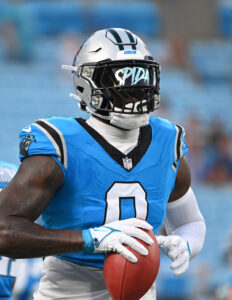 In what looks like a mistake, the Panthers passed on a Rams offer that included two first-rounders and a third for Burns at the 2022 trade deadline. Carolina then kept Burns out of 2023 trade talks with Chicago about the No. 1 pick, ultimately sending D.J. Moore to the Windy City for the Bryce Young draft slot. Carolina also kept Burns at the 2023 deadline, as teams looked into the top pass rusher on the NFL’s worst team. Burns also saw his position’s market change via Nick Bosa‘s record-setting extension ($34MM per year). The 49ers’ landmark accord came to pass after Burns had set a $30MM-AAV price point, complicating Morgan’s upcoming assignment.
In what looks like a mistake, the Panthers passed on a Rams offer that included two first-rounders and a third for Burns at the 2022 trade deadline. Carolina then kept Burns out of 2023 trade talks with Chicago about the No. 1 pick, ultimately sending D.J. Moore to the Windy City for the Bryce Young draft slot. Carolina also kept Burns at the 2023 deadline, as teams looked into the top pass rusher on the NFL’s worst team. Burns also saw his position’s market change via Nick Bosa‘s record-setting extension ($34MM per year). The 49ers’ landmark accord came to pass after Burns had set a $30MM-AAV price point, complicating Morgan’s upcoming assignment.
Burns, 25, has registered at least 7.5 sacks in each of his five seasons. While he has only topped nine in a season once (2022), the two-time Pro Bowler is one of the league’s better edge rushers. Given the Panthers’ history with Burns, it would be borderline shocking to see the team allow the Florida State alum to leave in exchange for merely a third-round compensatory pick.
Burns has said he wants to stay with the Panthers; he is unlikely to have a choice this year. The Panthers last used the tag to keep right tackle Taylor Moton off the market in 2021; the sides agreed to an extension that offseason.
Tee Higgins, WR (Bengals)
Tag cost: $21.82MM
Seeing their hopes of capitalizing on the final year of Higgins’ rookie contract dashed due to Joe Burrow‘s season-ending injury, the Bengals look to be giving strong consideration to keeping the Burrow-Higgins-Ja’Marr Chase trio together for one last ride of sorts. The Bengals hold $59.4MM in cap space — fifth-most currently — and structured Burrow’s extension in a way that makes a Higgins tag palatable. Burrow’s deal does not spike into historic cap territory until 2025.
 While a future in which Chase and Higgins are signed long term is more difficult to foresee, the Bengals still carry one of the AFC’s best rosters. It is likely Burrow’s top two weapons remain in the fold for at least one more year. Higgins, 25, did not come close to posting a third straight 1,000-yard season. Burrow’s injury had plenty to do with that, though the former second-round pick started slowly. A Bengals 2023 extension offer underwhelmed Higgins, but the Bengals kept him out of trades. A tag will give Cincinnati the option to rent him for 2024. A tag-and-trade transaction is viewed as unlikely, as the Bengals load up again.
While a future in which Chase and Higgins are signed long term is more difficult to foresee, the Bengals still carry one of the AFC’s best rosters. It is likely Burrow’s top two weapons remain in the fold for at least one more year. Higgins, 25, did not come close to posting a third straight 1,000-yard season. Burrow’s injury had plenty to do with that, though the former second-round pick started slowly. A Bengals 2023 extension offer underwhelmed Higgins, but the Bengals kept him out of trades. A tag will give Cincinnati the option to rent him for 2024. A tag-and-trade transaction is viewed as unlikely, as the Bengals load up again.
How the organization proceeds beyond 2024 will be a key storyline, but the Bengals — who kept Jessie Bates in similar fashion in 2022 — are positioned well to run back perhaps the NFL’s best receiving tandem. While director of player personnel Duke Tobin stopped short of guaranteeing Higgins will be a Bengal in 2024, signs point to it.
Justin Madubuike, DL (Ravens)
Tag cost: $22.1MM
Seeing their defensive coordinator depart and once again facing questions at outside linebacker, the Ravens have the option of keeping their top 2023 pass rusher off the market. They are probably going to take that route. Madubuike raised his price considerably during an impact contract year, leading the Ravens with 13 sacks. While Mike Macdonald was able to coax surprising seasons from late additions Jadeveon Clowney and Kyle Van Noy, Madubuike drove Baltimore’s defensive engine and will likely be guaranteed a high salary by signing his franchise tender.
 Perennially interested in hoarding compensatory picks, the Ravens have regularly let breakthrough pass rushers walk in free agency. This dates back to the likes of Paul Kruger and Pernell McPhee and subsequently included Za’Darius Smith and Matt Judon. The Ravens have only been able to replace Judon with stopgap options — from Clowney to Van Noy to Justin Houston — and again must figure out a solution alongside Odafe Oweh on the edge. Madubuike, 26, proved too good to let walk; the former third-round pick will once again be expected to anchor Baltimore’s pass rush in 2024.
Perennially interested in hoarding compensatory picks, the Ravens have regularly let breakthrough pass rushers walk in free agency. This dates back to the likes of Paul Kruger and Pernell McPhee and subsequently included Za’Darius Smith and Matt Judon. The Ravens have only been able to replace Judon with stopgap options — from Clowney to Van Noy to Justin Houston — and again must figure out a solution alongside Odafe Oweh on the edge. Madubuike, 26, proved too good to let walk; the former third-round pick will once again be expected to anchor Baltimore’s pass rush in 2024.
Antoine Winfield Jr., S (Buccaneers)
Tag cost: $17.12MM
We mentioned Winfield as the Bucs’ most likely tag recipient around the midseason point, and signs now point to that reality coming to pass. The Bucs want to re-sign Baker Mayfield and Mike Evans. The bounce-back quarterback’s tender price would check in at nearly $36MM, and because Evans was attached to a veteran contract, his tag number would come in well north of Higgins’ — at beyond $28MM. As such, the Bucs cuffing Winfield has always made the most sense, and after the second-generation NFL DB’s dominant contract year, it would be stunning to see the team let him walk.
The Bucs have let their recent top free agents test free agency, only to re-sign Shaquil Barrett (2021), Carlton Davis (2022) and Jamel Dean (2023). Winfield may be on a higher plane, having secured first-team All-Pro acclaim last season. Davis and Dean have never made a Pro Bowl; Winfield’s productive and well-regarded 2023 stands to separate him. Winfield, 25, tallied six sacks and three interceptions while forcing an NFL-leading six fumbles. This included a pivotal strip of DJ Chark in the Bucs’ Week 18 win over the Panthers, which clinched them the NFC South title.
 Winfield will undoubtedly be eyeing a top-market safety extension. Derwin James established the current standard, $19MM per year, just before the 2022 season. Last year’s safety market did not feature big-ticket prices, for the most part, but the Falcons made Jessie Bates (four years, $64MM) an exception. If Winfield were to reach free agency, he would be expected to eclipse that.
Winfield will undoubtedly be eyeing a top-market safety extension. Derwin James established the current standard, $19MM per year, just before the 2022 season. Last year’s safety market did not feature big-ticket prices, for the most part, but the Falcons made Jessie Bates (four years, $64MM) an exception. If Winfield were to reach free agency, he would be expected to eclipse that.
The Bucs, who have used the tag three times in the 2020s, should not be considered likely to let Winfield follow Davis and Dean’s path by speaking with other teams. Tampa Bay has used the tag three times in the 2020s, cuffing Barrett in 2020 and tagging Chris Godwin twice. The team eventually re-signed both, and while the statuses of Mayfield and Evans (and All-Pro tackle Tristan Wirfs) create a crowded contract queue, the Bucs will certainly be interested in re-upping Winfield.
On tag radar
Saquon Barkley, RB (Giants)
Tag cost: $12MM
Barkley has said he wants to finish his career with the Giants, and the team will meet with the Pro Bowl running back’s camp at the Combine. But a recent report indicated the team is highly unlikely to tag the six-year veteran a second time. The Giants should not be ruled out from reversing course and keeping Barkley, given his importance to an otherwise low-octane offense, but it appears they are prepared to move on if the talented RB does not accept their extension offer this time around. A host of talented backs await in free agency, though Barkley would likely be the top prize were he to reach the market.
Read more
Kyle Dugger, S (Patriots)
Tag cost: $17.12MM
With Michael Onwenu profiling as too expensive to tag — especially if the Patriots see him as a guard long term, Dugger looks like the more logical candidate to be retained. Though, it is far from a lock New England pulls the trigger. The team is, however, retaining some of its top defensive staffers. Continuity will help the 27-year-old defender’s chances of sticking in Foxborough. The Pats last used the tag on Joe Thuney in 2020.
More of an asset in the box, Dugger has been a key part of the Patriots’ defense. He has also intercepted nine passes since 2021, returning two for scores (both in 2022). PFF slotted Dugger as a top-15 safety in ’22 but viewed his coverage as spotty enough to place him outside the top 65 last season. The Pats kept Dugger at the deadline, though extension talks did not produce much momentum. A tag would represent a steep cost to prolong those negotiations and ensure the Division II alum stays an extra year. A nice market will form if Dugger is allowed to speak with other teams.
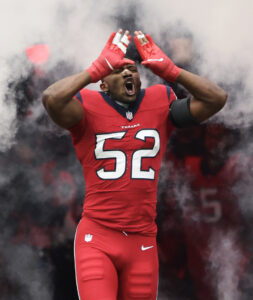 Jonathan Greenard, DE (Texans)
Jonathan Greenard, DE (Texans)
Tag cost: $21.32MM
Greenard served as a productive pass rusher before and after DeMeco Ryans‘ arrival, showing another gear opposite Will Anderson last season. The fourth-year pass rusher totaled a Texans-leading 12.5 sacks — a career-high number by a wide margin. Greenard, 26, totaled 22 QB hits and tied (with Anderson) for 20th with 32 pressures last season.
If the Texans do not tag Greenard, they run the risk of losing him on a market that will probably not include Allen or Burns. That naturally will help the causes of the next-best pass rushers available. Still, this price would be fairly high for Greenard. Interested in retaining the former third-round pick, the Texans can still re-sign him before the March 11 tampering period.
With Anderson and C.J. Stroud on rookie deals through at least 2025, the team remains in good position to make a competitive offer. Holding more than $54MM in cap space, the Texans sit seventh in available funds. Houston, which last used the tag on Jadeveon Clowney in 2019 (preceding a trade), could ensure Greenard does not get away by tagging him. That could set up a rental scenario, though carrying a $20MM cap number would be pricey.
Bryce Huff, DE (Jets)
Tag cost: $21.32MM
Like Barkley, the Jets are more likely than not to pass here. Teams will be monitoring this situation. Huff led the Jets with 10 sacks last season and paced the NFL in pressure rate, beating out Micah Parsons with a 21.8% number. The Jets want to re-sign the former UDFA, but they also seemingly chose his replacement in first-rounder Will McDonald last year. It did not appear New York’s intention to draft McDonald, and he played little as a rookie. After not extending an offer to Huff during the season, Gang Green appears close to letting him test the waters.
The Jets will likely want their top 2023 pick on the field more, though that probably means saying goodbye to a blossoming pass rusher. The team may well view Huff as more of a DH. The Jets kept his snaps below 500 and saw PFF slot him as one of the worst run-defending edges. But clubs, especially if Burns and Allen are out of the mix, will be interesting in paying for a 26-year-old edge player. The Jets have not used the tag since cuffing Marcus Maye in 2021.
 Josh Jacobs, RB (Raiders)
Josh Jacobs, RB (Raiders)
Tag cost: $12.4MM
After three running backs were kept off the 2023 market, none may be ticketed for a 2024 tag. The Raiders will undoubtedly look to extend this partnership without applying a tag, which is slightly more expensive than Barkley’s due to the team giving Jacobs a rare pay bump to bring him into the fold after a prolonged tag-driven absence. Jacobs, 25, could not come close to matching his 2022 dominance. The Jon Gruden-era first-rounder finished with less than half his 2022 rushing yardage, totaling 805 on the ground in his fifth season.
Jacobs has expressed interest in staying under HC Antonio Pierce, joining teammates in lobbying ownership to retain the popular interim boss. While the only way the Raiders can ensure Jacobs stays is to bring out the tag, the team probably will be OK competing for him on the open market rather than carry a $12.4MM tender price on its books to start Tom Telesco‘s GM tenure.
Michael Pittman Jr., WR (Colts)
Tag cost: $21.82MM
Becoming the Colts’ No. 1 wide receiver as T.Y. Hilton‘s career wound down, Pittman has been Indianapolis’ go-to pass catcher for most of his career. Under GM Chris Ballard, the Colts have generally avoided letting homegrown standouts reach the free agency precipice. They have re-signed the likes of Ryan Kelly, Braden Smith, Quenton Nelson, Shaquille Leonard and Jonathan Taylor before their contract seasons began. While the Taylor process featured turbulence, that matter is resolved. As that high-profile impasse played out, Pittman trudged through his contract year. Perhaps benefiting from raw passer Anthony Richardson‘s injury, the 26-year-old receiver posted career-high totals in receptions (109) and yards (1,152) to boost his value ahead of free agency.
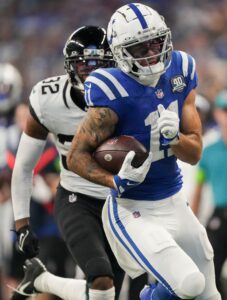 The 6-foot-4 wideout has naturally expressed interest in testing the market, after indicating some disappointment in not being extended earlier. But the second-generation NFLer also did not sound like he would be displeased with a tag. Aside from the Philip Rivers payment in 2020, Ballard has generally been cautious in free agency. But keeping cornerstone players serves as the eighth-year front office boss’ central philosophy.
The 6-foot-4 wideout has naturally expressed interest in testing the market, after indicating some disappointment in not being extended earlier. But the second-generation NFLer also did not sound like he would be displeased with a tag. Aside from the Philip Rivers payment in 2020, Ballard has generally been cautious in free agency. But keeping cornerstone players serves as the eighth-year front office boss’ central philosophy.
It would not surprise to see the Colts, now free of the spree of veteran contracts at quarterback, make Pittman untouchable soon. The Colts have not used the tag in 11 years, since they kept Pat McAfee off the 2013 market.
L’Jarius Sneed, CB (Chiefs)
Tag cost: $19.8MM
Because the Chiefs tagged Chris Jones in 2020, the All-Pro defensive tackle’s 2024 tag price — 120% of his pre-restructure 2023 payment — would come in beyond $32MM. Only the Ravens have ventured past $30MM for a tag, and it was for now-two-time MVP Lamar Jackson. Jones is almost definitely headed to free agency, and while the potential Hall of Fame DT has said he is interested in being part of the Chiefs’ threepeat push, he will command a monster salary. A very real prospect exists the Chiefs lose their top two defenders in free agency.
Of course, the Chiefs can prevent this scenario by tagging Sneed. It would involve deviating from an apparent core Andy Reid-Steve Spagnuolo principle of not paying cornerbacks. But Sneed submitted arguably the best season of any Spagnuolo-era Chiefs cover man. Although overlooked for the Pro Bowl and All-Pro teams, Sneed regularly covered No. 1 receivers and allowed only a 56.2 passer rating as the closest defender. That is close to Johnson’s Chicago numbers that are set to produce a tag, and Sneed — a three-time Super Bowl starter — has shown the ability to play outside and patrol the slot.
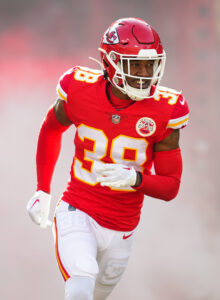 Kansas City, however, has kept the assembly line going at this position by acquiring cheap talent to replace departing starters. After trading Marcus Peters in 2018, the Chiefs let Steven Nelson (2019), Kendall Fuller (2020) and Charvarius Ward (2022) sign elsewhere. It took a three-year, $40MM accord for the 49ers to pry Ward away; Sneed will probably top that if he reaches the market.
Kansas City, however, has kept the assembly line going at this position by acquiring cheap talent to replace departing starters. After trading Marcus Peters in 2018, the Chiefs let Steven Nelson (2019), Kendall Fuller (2020) and Charvarius Ward (2022) sign elsewhere. It took a three-year, $40MM accord for the 49ers to pry Ward away; Sneed will probably top that if he reaches the market.
Although the Chiefs have All-Pro Trent McDuffie and fellow 2022 draftees Joshua Williams and Jaylen Watson on rookie deals, ensuring Sneed stays would certainly help the team make a spirited effort to become the first to win three straight titles in the Super Bowl era. The Chiefs protected Orlando Brown Jr. in 2022, and while they failed to reach a long-term agreement that summer, the rental helped produce a Super Bowl LVII title.
Christian Wilkins, DT (Dolphins)
Tag cost: $22.1MM
The 2019 first round brought a number of upper-echelon defensive tackles into the NFL. Most of the contingent signed extensions before their fifth season. After 2018 draftee Daron Payne locked in his deal, the floodgates for the ’19 picks opened. Jeffery Simmons, Dexter Lawrence, Ed Oliver and Quinnen Williams signed extensions. Despite months of talks with the Dolphins, Wilkins did not follow suit. He staged a hold-in effort briefly, though the Dolphins rebuffed trade overtures. Tabling talks to this year, Miami is prepared for another chapter. Unless the Dolphins are ready to hammer out a deal before the tampering period, they will need to tag their top DT.
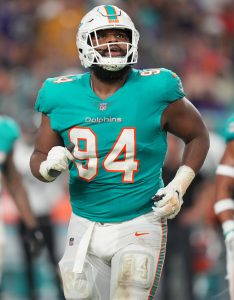 Miami has some notable payments on its front, having extended Bradley Chubb and Zach Sieler. But Wilkins showed another gear in his contract year. Leery of going into the Lawrence-Simmons-Williams range ($22.5-24MM per year) for a player who had topped out at 4.5 sacks in a season previously, the Dolphins saw Wilkins, 28, spearhead an increasingly injury-laden pass rush by tallying nine sacks to go with Sieler’s 10. Wilkins added 23 QB hits.
Miami has some notable payments on its front, having extended Bradley Chubb and Zach Sieler. But Wilkins showed another gear in his contract year. Leery of going into the Lawrence-Simmons-Williams range ($22.5-24MM per year) for a player who had topped out at 4.5 sacks in a season previously, the Dolphins saw Wilkins, 28, spearhead an increasingly injury-laden pass rush by tallying nine sacks to go with Sieler’s 10. Wilkins added 23 QB hits.
The Dolphins, who used the tag in 2022 on Mike Gesicki, are more than $51MM over the cap. It will take more than an Emmanuel Ogbah release to move into range to tag Wilkins. But the prospect should be considered in play, given the Clemson alum’s importance to the defense.
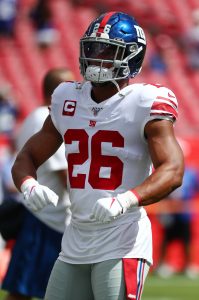
 Ryan Dunleavy of the New York Post confirms the expectation around the league is that general manager Nick Caserio will be a central player in the RB market this offseason. Caserio has a background with the Patriots, a team which has traditionally avoided making sizable investments in veteran backs. A shift in philosophy would thus come as a surprise, although an upgrade at the position would likely go a long way in ensuring the team can repeat its success on offense from 2023.
Ryan Dunleavy of the New York Post confirms the expectation around the league is that general manager Nick Caserio will be a central player in the RB market this offseason. Caserio has a background with the Patriots, a team which has traditionally avoided making sizable investments in veteran backs. A shift in philosophy would thus come as a surprise, although an upgrade at the position would likely go a long way in ensuring the team can repeat its success on offense from 2023.

